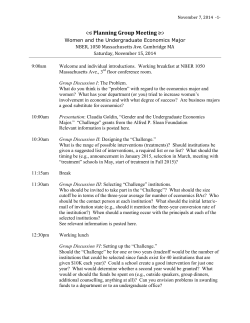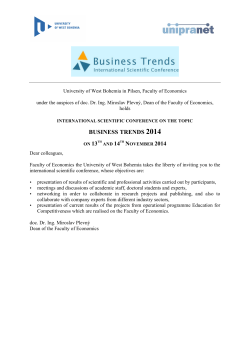
Quarterly Economic Forecast - U.S. Economic Outlook
QUARTERLY ECONOMIC FORECAST
TD Economics
December 17, 2014
U.S. OUTLOOK: THE TIDE IS TURNING
Highlights
• The tide is turning for the American economic outlook. Economic growth surpassed expectations
over the past two quarters of 2014, growing by an average of 4.2% (annualized). Growth was led by
an upsurge in spending by households and businesses.
• Job growth has continued to strengthen over the course of 2014 and rests on a strong foundation
of rising job openings and increasing labor market turnover. This sets the stage for stronger wage
growth, which feeds back directly on the consumer spending outlook.
• Household spending will be further supported by the decline in energy prices. Oil and gasoline prices
have fallen over 40% since our last economic forecast in September. This is a net-positive for the
U.S. economy, saving the average American household around $500 a year.
• Strengthening domestic fundamentals are offset somewhat by a struggling global economy. We have
lowered our expectations for global growth (excluding the U.S.) by 0.3 percentage points over the
next year. In combination with a rapidly rising dollar, this will make for a challenging environment for
American exporters.
• After averaging 2.3% in 2014, the U.S. economy is expected to grow by 3% in 2015. In 2016, real
GDP growth is expected to moderate to 2.7%, as the economy edges closer to full employment.
• Despite falling inflation on account of lower energy prices and the rising dollar, the continued improvement in the labor market will lead the Federal Reserve to raise interest rates in the second half of
next year.
It’s hard to ignore the momentum in the American economy. Real GDP growth bounced back firmly
from the setback at the start of the year, averaging 4.2% (annualized) in the second and third quarters – the
fastest two-quarter pace of the recovery to date. Growth was led by private domestic demand – spending
by households and businesses – that averaged 3.5%.
CHART 1: REAL GROSS DOMESTIC PRODUCT
The conditions are in place for this to continue. Consumer
and business confidence is steadily recovering and balance sheets 6 Percentchange(annualized)
Forecast
look increasingly healthy. The labor market recovery is built on a 4
strong foundation of rising job openings and increasing turnover.
2
This is the recipe for stronger wage growth. As an added boost to
household incomes, the steep decline in energy prices over the past 0
three months will save the average American household $500 a -2
Y/Y%chg.
year. Since our last Quarterly Economic Forecast, oil and gasoline -4
(Q4/Q4%chg)
2014F2.3%(2.2%)
prices have fallen over 40%.
-6
2015F3.0%(2.8%)
2016F2.7%(2.5%)
However, strengthening domestic fundamentals are increasingly
-8
being set apart from a difficult global environment that will weigh
on the trade deficit and headline GDP growth. Since September, -10 2008 2009 2010 2011 2012 2013 2014 2015 2016
we have brought down our 2015 expectation for global economic
ForecastbyTDEconomics,December2014
Source:BureauofEconomicAnalysis
growth (outside of the United States) by 0.3 percentage points.
Craig Alexander, SVP & Chief Economist
Beata Caranci, VP & Deputy Chief Economist
James Marple, Senior Economist
www.td.com/economics
@CraigA_TD
TD Economics | www.td.com/economics
With the dollar rising, this will make for a more challenging
environment for U.S. exporters. At the same time, some of
the additional domestic consumption will be satisfied by
imported goods.
The rising dollar will also mean lower inflation, which
will allow the Federal Reserve to leave rates on hold through
the first half of the year, even as the unemployment rate
continues to move down.
All told, following growth of 2.3% in 2014, we expect
the U.S. economy to accelerate to 3.0% in 2015. Economic
growth will likely moderate to 2.7% in 2016 as the economy
moves closer to full employment.
Falling oil prices lift the outlook for consumer
spending
By far the biggest change to the economic outlook over
the past three months has been the decline in energy prices.
The price for a barrel of crude oil had already been declining
at the time of our last forecast in September, but the descent
has turned into a rout over the last several weeks. The price
of the West Texas Intermediate (WTI) and Brent benchmarks
fell 10% in a single week at the end of November.
The fall in oil prices reflects both supply and demand
factors. The catalyst for recent declines was the reduction
in global growth expectations, which have led forecasters
to downgrade their expectations for oil consumption over
the next few years.
The supply-side factors have been longer in the making
and have a lot do to with energy production in America.
The increase in American oil production has been truly astounding. Over the past three years, America has added the
CHART 2: OIL AND GASOLINE PRICES
220
Indexed;2009=100
200
180
160
140
120
100
80
WTI
60
Regulargasoline
40
2009
2010
2011
2012
Source:WallStreetJournal/HaverAnalytics.
December 17, 2014
2013
2014
CHART 3: REAL SPENDING
ON GASOLINE & OTHER MOTOR FUEL
4.0
Perhousehold;thousandsofconstant2014dollars
3.5
3.0
2.5
Centered12month
movingaverage
2.0
1.5
2000
2002
2004
2006
2008
2010
2012
2014
Source:BureauofEconomicAnalysis,TDEconomics.
equivalent of the annual production of Libya each year. In
2013, the United States produced more crude oil than Saudi
Arabia. Increased North American production has cut into
the market share of the OPEC. Instead of cutting back on
supply to stabilize prices, the cartel has decided to compete
for market share.
The fall in prices will yield demand and supply responses
that, over time, help to pull the price of oil back up. On the
supply side, the lower price will squeeze out more marginal
producers. This is the downside to the decline in energy
prices. In states that are particularly dependent on oil and gas
extraction – such as Texas and North Dakota – the reduction
in investment and employment will mean slower economic
growth. While this impact will be smaller nationally, it has
led us to revise down our expectation for business investment, due the declines in the oil and gas sector. The decline
in oil prices may also expose financial vulnerabilities as the
viability of loans to the fast-growing oil and gas sector are
brought into question.
On the demand side, lower prices are likely to result in
greater global fuel consumption, especially in emerging
markets. After averaging just $60 in the first quarter, we
expect the WTI price to slowly grind upward, reaching $75
by the end of 2015 and $83 by the end of 2016. The increase
will be echoed in gasoline prices.
In the meantime, the decline in prices is a boon to
American consumers. Households spent roughly $3,300
on gasoline over the last year. With the decline in prices,
this will fall to around $2,800 over the next year, a savings
of $500. This is roughly equivalent to the fiscal stimulus of
mid-2008. The additional money will provide a boost to
2
TD Economics | www.td.com/economics
growth by 0.6 percentage points in 2015.
CHART 4: BROAD TRADE-WEIGHTED DOLLAR
114
Index; January2007=100
114
111
111
108
108
Forecast
105
105
102
102
99
99
96
2012
2013
2014
2015
2016
96
Source:Federal ReserveBoard.ForecastbyTDEconomics
consumer spending, which we have lifted by 0.3 percentage points in 2015 relative to our September forecast. As
prices gradually rise, it will subtract modestly from spending growth through 2016. However, the rise in prices is not
expected to be nearly as swift as the decline, and will be
offset by rising incomes.
The dollar’s Orion-like ascent will be a challenge to
exporters
The flipside of the decline in oil prices is the rise in
the dollar. While we had been anticipating a rise in the
greenback, its ascent has been faster than expected. Since
September, the trade-weighted dollar has risen over 4%.
This is slightly more than the increase that had taken place
between June and September.
The rise in the U.S. dollar reflects a divergence in market expectations for economic growth and monetary policy
between America and the rest of the world. While economic
data has repeatedly beaten expectations on the upside in
America, it has repeatedly disappointed elsewhere. In Japan,
the economy shrunk for two consecutive quarters following the introduction of a sales tax hike in April. In the euro
zone, growth has been lacklustre and inconsistent, with
weakness more pronounced in core countries. Emerging
markets meanwhile have been hit by a confluence of factors
including: slowing growth in China, increased geopolitical
tensions, and, for many commodity producers, declining
prices.
The combination of weak global growth and a higher
dollar means slower growth in exports and a bigger rise in
imports. All told, we expect net exports to reduce economic
December 17, 2014
Falling inflation amid rising growth – the Fed’s new
balancing act
Lower energy prices and a stronger dollar will both
weigh on price growth over the next year. Overall consumer
price inflation (in year-over-year terms) is likely to trough
in the second quarter of next year at just 0.7%. The decline
in the headline rate mainly reflects the fall in energy prices,
which will subtract close to a percentage point from inflation
directly over this period.
Core inflation – excluding food and energy prices – will
prove sturdier, but is also likely to remain below the Federal
Reserve’s target over the next two years. Energy is an input
into a wide array of consumer items. Over time it will show
up in broad consumer prices. The story is the same for the
pass-through of a higher dollar. While the impact may be
small at first, it will grow over time, as the lower cost of
imports is passed on to consumers.
Against this backdrop is the reality of a tightening labor
market. Eventually, the improved labor market will win out,
bringing inflation higher. While the rate of wage growth
remains short of historical norms, it is moving up.
The challenge for the Federal Reserve is that it does
not set policy for the inflation rate today, but for where it
expects it to be in the future. It must therefore look through
the temporary weakness in inflation to indicators of future
price growth. The increase in labor market turnover and
the rise in job openings are a sign that wage growth will
continue to move higher.
As long as the economy continues to show improvement,
CHART 5: CONSUMER PRICE INFLATION
6
5
Year-over-year%change
CPI
CoreCPI*
Forecast
4
3
2
1
0
-1
-2
2005 2006 2007 2008 2009 2010 2011 2012 2013 2014 2015 2016
*Excludingfoodandenergy.SourceBureauofLaborStatistics.
ForecastbyTDEconomics
3
TD Economics | www.td.com/economics
sudden disruption to credit markets is the most obvious
downside risk to the economic outlook.
CHART 6: INTEREST RATES
4.0
Yieldatend-of-period,%
Bottom line
2013
3.5
2014
2015
3.0
2016
2.5
2.0
1.5
1.0
0.5
0.0
Fedfunds
rate
3-month
2-year
5-year
10-year
30-year
Source:TDEconomics.ForecastasofDecember2014
the Federal Reserve will lift interest rates next year. Developments since our last forecast round have not led to changes
in our view on the timing of the first rate hikes. While the
composition of growth has shifted toward domestic spending
and away from foreign demand, the overall rate of economic
growth and job creation is largely unchanged. As such, we
continue to expect the Fed to raise rates at their September
meeting, bringing the target for the fed funds rate to 0.75%
by the end of 2015.
As policy normalization draws closer, however, we must
recognize that this in itself is a source of risk to the economic
outlook. Given the amount of leverage still in the global
financial system and the search for yield that has come out
of the prolonged period of extra-low rates, there is a chance
that policy removal will not go totally smoothly. We know
from the 2013 taper tantrum experience that markets may
not treat the gradual withdrawal of stimulus as gradual. A
December 17, 2014
In many ways, the American economy is in a goldilocks
position. The stronger U.S. dollar and weakening commodity prices have led to a disinflationary impulse just as the
labor market is tightening and pushing up wages. Finally,
after years of stagnation, real wages are moving up.
With November’s job report, the American economy has
experienced 10 consecutive months of job growth in excess
of 200 thousand. Moreover, the strength in employment
growth is increasingly broad based. The share of industries
adding jobs is the highest in 17 years at close to 70%. Following several years of painful deleveraging and weak
spending growth, the good news is a long time coming.
With the boost to real income growth from lower energy
prices, the outlook for consumer spending is substantially
better over the next year.
Add to this the fact that we still have a long way to go
before the housing market is back to normal. Another 50%
rise in housing construction is expected to take place over
the next several years. Mortgage rates have fallen and regulations are becoming more favorable for first-time homebuyers, which gives confidence to our forecast for housing starts.
This all plays out in our forecast for domestic demand
growth, which rises well above 3.0% in 2015. Although
there is a partial offset stemming from weak net-exports,
America is still a relatively closed economy. The drag from
abroad will not be enough to forestall the acceleration in
economic growth.
4
TD Economics | www.td.com/economics
U.S. ECONOMIC OUTLOOK:
Period-Over-Period Annualized Per Cent Change Unless Otherwise Indicated
2014
Q1
Real GDP
Q2
2015
Q3
2016
Annual Average
Q4F Q1F Q2F Q3F Q4F Q1F Q2F Q3F Q4F
14F
15F
16F
4th Qtr/4th Qtr
14F
15F
16F
-2.1
4.6
3.9
2.5
2.6
2.7
3.0
2.9
2.5
2.6
2.4
2.5
2.3
3.0
2.7
2.2
2.8
2.5
Consumer Expenditure
1.2
2.5
2.2
3.4
3.1
3.3
3.2
2.9
2.5
2.6
2.4
2.3
2.3
3.1
2.7
2.3
3.1
2.4
DurableGoods
3.2 14.1
8.7
4.3
7.0
5.8
5.4
4.8
3.9
4.4
3.7
3.4
6.7
6.5
4.4
7.5
5.7
3.9
Business Investment
1.6
9.7
7.1
3.8
5.0
5.4
6.6
6.5
5.6
4.5
3.8
3.5
6.0
5.7
5.3
5.5
5.8
4.4
Non-Res.Structures
2.9 12.6
1.1
2.2
1.8
2.4
3.7
3.4
3.8
4.2
3.7
3.1
7.4
2.9
3.6
4.6
2.8
3.7
Equipment&IPP*
1.2
8.9
9.0
4.3
5.9
6.2
7.5
7.4
6.2
4.6
3.9
3.6
5.6
6.5
5.8
5.8
6.8
4.6
Residential Construction
-5.3
8.8
2.7
9.6 13.2 13.7 15.3 15.9 12.7 11.4 10.1
9.2
1.9
11.5
12.8
3.8
14.5
10.8
Govt. Consumption
& Gross Investment
-0.8
1.7
4.2
-1.2
1.2
1.1
0.9
1.0
0.7
0.8
0.9
0.7
-0.1
1.1
0.8
0.9
1.0
0.8
0.7
3.4
3.2
2.8
3.3
3.5
3.6
3.5
2.9
2.8
2.6
2.5
2.3
3.3
3.1
2.5
3.5
2.7
Exports
-9.2 11.0
4.9
3.7
2.0
3.5
4.4
4.7
5.0
5.6
5.2
5.5
3.2
4.0
4.9
2.3
3.6
5.3
Imports
2.2 11.3
-0.7
6.3
6.1
6.6
7.2
7.0
6.3
5.8
5.3
4.5
3.8
5.9
6.2
4.7
6.7
5.5
Change in Private
Inventories
35.2 84.8 79.1 83.8 81.8 70.4 64.2 58.8 53.6 50.7 48.9 47.9
70.7
68.8
50.3
---
---
---
Final Sales
-1.0
2.5
2.2
3.0
2.8
2.1
3.0
2.6
International Current
Account Balance ($Bn)
-466 -440 -459 -413 -374 -373 -385 -397 -402 -397 -394 -383
-444
-382
-394
---
---
---
-2.7
Final Domestic Demand
%ofGDP
Pre-tax Corporate Profits
including IVA&CCA
%ofGDP
GDP Deflator (Y/Y)
Nominal GDP
Labor Force
3.2
4.1
2.4
2.7
3.0
3.2
3.1
2.7
2.7
2.5
-2.5
-2.6
-2.3
-2.1
-2.1
-2.1
-2.1
-2.1
-2.1
-2.1
-2.0
-2.6
-2.1
-2.1
---
---
---
-32.6 38.3
8.6
8.7
2.3
2.8
3.2
3.2
3.1
2.9
2.8
2.8
-0.4
6.4
3.0
2.4
2.9
2.9
11.4 12.2 12.2 12.4 12.3 12.3 12.2 12.2 12.1 12.1 12.0 12.0
12.0
12.3
12.1
---
---
---
1.4
1.6
1.6
1.5
1.5
1.4
1.5
1.7
1.9
2.0
2.0
2.0
1.5
1.5
2.0
1.5
1.7
2.0
-0.8
6.8
5.3
3.5
4.0
4.5
4.9
4.9
4.8
4.6
4.5
4.6
3.8
4.5
4.7
3.7
4.6
4.6
2.2
-0.6
1.0
1.2
1.0
1.0
0.9
1.0
0.9
1.0
0.9
0.9
0.4
0.9
1.0
0.9
1.0
0.9
1.8
2.0
1.6
2.0
1.8
1.5
Employment
1.5
2.2
2.1
2.2
2.0
1.7
1.8
1.6
1.6
1.5
1.4
1.3
Change in Empl. ('000s)
507
755
723
760
695
608
639
575
570
544
511
480 2,510 2,734 2,256 2,745 2,516 2,105
Unemployment Rate (%)
6.7
6.2
6.1
5.8
5.6
5.5
5.4
5.4
5.3
5.3
5.2
5.2
6.2
5.5
5.2
---
---
---
Personal Disp. Income
4.8
5.5
3.6
3.0
4.3
4.8
5.2
5.1
5.1
4.9
4.8
4.8
3.8
4.3
5.0
4.2
4.8
4.9
Pers. Saving Rate (%)
4.9
5.1
5.0
5.0
5.2
5.1
5.0
5.0
5.0
5.0
5.0
5.0
5.0
5.1
5.0
---
---
---
Cons. Price Index (Y/Y)
1.4
2.1
1.8
1.3
1.0
0.7
1.0
1.7
2.1
2.2
2.3
2.3
1.6
1.1
2.2
1.3
1.7
2.3
1.6
1.9
1.8
1.8
1.9
1.7
1.7
1.7
1.8
1.9
2.1
2.2
1.8
1.7
2.0
1.8
1.7
2.2
0.93 0.99 1.03 1.04 1.08 1.15 1.23 1.30 1.36 1.42 1.47 1.51
1.00
1.19
1.44
---
---
---
0.7
1.1
1.4
-0.1
1.4
1.3
Core CPI (Y/Y)
Housing Starts (mns)
Productivity:
Real Output per hour (y/y)**
0.7
1.3
1.0
-0.1
1.3
0.9
0.7
1.4
1.5
1.5
1.4
1.3
*Intellectualproprtyproducts.**Non-farmbusinesssector.F:ForecastbyTDEconomics,December2014
Source:U.S.BureauofLaborStatistics,U.S.BureauofEconomicAnalysis,TDEconomics
December 17, 2014
5
TD Economics | www.td.com/economics
INTEREST RATE OUTLOOK
2014
2015
2016
Q1
Q2
Q3
Q4F
Q1F
Q2F
Q3F
Q4F
Q1F
Q2F
Q3F
Q4F
FedFundsTargetRate(%)
0.25
0.25
0.25
0.25
0.25
0.25
0.50
0.75
1.00
1.25
1.50
1.75
3-mthT-BillRate(%)
0.05
0.04
0.02
0.05
0.10
0.15
0.40
0.65
0.85
1.10
1.30
1.55
2-yrGovt.BondYield(%)
0.44
0.47
0.58
0.50
0.80
1.00
1.25
1.50
1.65
1.90
2.15
2.35
5-yrGovt.BondYield(%)
1.73
1.62
1.78
1.55
1.85
2.00
2.25
2.30
2.50
2.70
2.85
2.95
10-yrGovt.BondYield(%)
2.73
2.53
2.52
2.20
2.50
2.65
2.90
2.90
3.10
3.30
3.40
3.50
30-yrGovt.BondYield(%)
3.56
3.34
3.21
2.85
3.10
3.20
3.40
3.40
3.55
3.70
3.80
3.85
10-yr-2-yrGovt.Spread(%)
2.29
2.06
1.94
1.70
1.70
1.65
1.65
1.40
1.45
1.40
1.25
1.15
F:ForecastbyTDEconomics,December2014;Allforecastsareforendofperiod;Source:Bloomberg,TDEconomics
FOREIGN EXCHANGE OUTLOOK
Currency
Exchange Rate
2014
2015
2016
Q1
Q2
Q3
Q4F
Q1F
Q2F
Q3F
Q4F
Q1F
Q2F
Q3F
Q4F
1.12
Canadiandollar
CADperUSD
1.11
1.07
1.12
1.15
1.15
1.18
1.19
1.18
1.14
1.14
1.12
Japaneseyen
JPYperUSD
103
101
110
119
120
122
125
125
125
125
120
120
Euro
USDperEUR
1.38
1.37
1.26
1.25
1.23
1.22
1.18
1.18
1.20
1.22
1.24
1.24
U.K.pound
USDperGBP
1.67
1.71
1.62
1.56
1.56
1.55
1.53
1.57
1.60
1.63
1.68
1.68
Swissfranc
CHFperUSD
0.88
0.89
0.96
0.96
0.98
0.98
1.03
1.03
1.02
1.00
0.98
0.98
Australiandollar
USDperAUD
0.93
0.94
0.87
0.82
0.88
0.85
0.85
0.84
0.83
0.82
0.81
0.80
NZdollar
USDperNZD
0.87
0.88
0.78
0.78
0.78
0.74
0.73
0.72
0.70
0.68
0.67
0.65
F:ForecastbyTDEconomics,December2014;Allforecastsareforendofperiod;Source:FederalReserve,Bloomberg,TDEconomics
December 17, 2014
6
TD Economics | www.td.com/economics
GLOBAL ECONOMIC OUTLOOK
ECONOMIC INDICATORS FOR THE G-7 AND EUROPE
Annual per cent change unless otherwise indicated
Real GDP
World
North America
UnitedStates
Canada
Mexico
European Union (EU-28)
Euro-zone(EU-17)
Germany
France
Italy
UnitedKingdom
EUaccessionmembers
Asia
Japan
AsianNIC's
HongKong
Korea
Singapore
Taiwan
Russia
Australia&NewZealand
DevelopingAsia
ASEAN-4
China
India**
Central/South America
Brazil
Other Developing
Other Advanced
2013 Share*
(%) 2013
99.9 3.3
20.0 2.1
16.5 2.2
1.5 2.0
2.0 1.1
17.2 0.2
12.3 -0.4
3.4 0.1
2.5 0.3
2.0 -1.9
2.3 1.7
2.7 1.4
41.3 5.2
4.6 1.5
3.4 2.8
0.4 2.9
1.7 3.0
0.4 3.9
1.0 2.1
3.4 1.3
1.2 2.4
28.7 6.6
4.6 5.2
15.8 7.7
6.6 4.7
6.7 3.2
3.0 2.5
13.7 3.5
1.0 1.9
Forecast
2014 2015 2016
3.2
3.4
3.6
2.3
3.0
2.8
2.3
3.0
2.7
2.4
2.3
2.2
2.1
3.5
3.9
1.4
1.4
1.6
0.8
0.9
1.4
1.5
1.1
1.4
0.4
0.7
1.2
-0.4 0.2
0.9
3.0
2.4
2.0
2.3
2.5
2.7
4.9
4.7
4.9
0.2
0.9
1.0
3.3
3.5
3.6
2.0
2.8
3.3
3.5
3.7
3.6
3.1
3.5
3.5
3.5
3.6
3.8
0.4 -3.5 -1.0
2.8
2.4
3.4
6.4
6.4
6.4
4.6
5.1
5.1
7.4
7.0
6.7
5.4
6.1
6.5
0.7
1.6
2.6
0.1
0.8
2.1
2.9
3.5
4.1
1.8
2.0
2.3
*ShareofworldGDPonapurchasing-power-paritybasis.
ForecastasatDecember2014.**ForecastforIndiareferstoFY.
Source:IMF,TDEconomics.
2013
2014
Forecast
2015
2016
Real GDP (Annual per cent change)
G-7 (32.7%)*
U.S.
Japan
EZ
Germany
France
Italy
UnitedKingdom
Canada
1.5
1.7
2.1
2.0
2.2
1.5
-0.5
0.1
0.4
-1.9
1.7
2.0
2.3
0.2
0.8
1.5
0.4
-0.4
3.0
2.4
3.0
0.9
0.9
1.1
0.7
0.2
2.4
2.3
2.7
1.0
1.4
1.4
1.2
0.9
2.0
2.2
Consumer Price Index (Annual per cent change)
G-7
U.S.
Japan
EZ
Germany
France
Italy
UnitedKingdom
Canada
1.3
1.6
1.1
1.8
1.5
0.4
1.3
1.6
1.0
1.3
2.6
0.9
1.6
2.8
0.5
0.8
0.6
0.2
1.5
2.0
1.1
1.4
0.7
0.9
0.8
0.4
1.2
1.5
2.2
1.1
1.2
1.7
1.3
1.1
1.9
2.1
Unemployment Rate (Per cent annual averages)
U.S.
Japan
EZ
Germany
France
Italy
UnitedKingdom
Canada
7.4
4.0
12.0
5.2
10.3
12.2
7.5
7.1
6.2
3.6
11.6
5.0
10.3
12.8
6.3
6.9
5.5
3.5
11.3
4.8
10.4
12.8
6.0
6.7
5.2
3.5
11.0
4.7
10.0
12.4
6.0
6.7
*Shareof2013worldgrossdomesticproduct(GDP)
ForecastasatDecember2014
Source:Nationalstatisticsagencies,TDEconomics
This report is provided by TD Economics. It is for informational and educational purposes only as of the date of writing, and may not be
appropriate for other purposes. The views and opinions expressed may change at any time based on market or other conditions and
may not come to pass. This material is not intended to be relied upon as investment advice or recommendations, does not constitute a
solicitation to buy or sell securities and should not be considered specific legal, investment or tax advice. The report does not provide
material information about the business and affairs of TD Bank Group and the members of TD Economics are not spokespersons for TD
Bank Group with respect to its business and affairs. The information contained in this report has been drawn from sources believed to
be reliable, but is not guaranteed to be accurate or complete. This report contains economic analysis and views, including about future
economic and financial markets performance. These are based on certain assumptions and other factors, and are subject to inherent
risks and uncertainties. The actual outcome may be materially different. The Toronto-Dominion Bank and its affiliates and related entities
that comprise the TD Bank Group are not liable for any errors or omissions in the information, analysis or views contained in this report,
or for any loss or damage suffered.
December 17, 2014
7
© Copyright 2025













